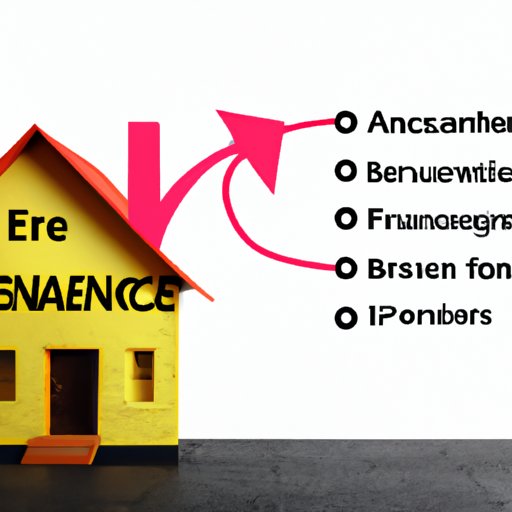Introduction
When it comes to managing your finances, there are few decisions more important than choosing a mortgage. With the right loan, you can save thousands of dollars in interest over the life of the loan. But what happens when you want to take advantage of better terms or lower rates? That’s where refinancing comes in.
Refinancing is the process of taking out a new loan to pay off an existing loan. It can be a great way to save money by taking advantage of lower interest rates or shorter repayment terms. But how much does refinancing cost? Let’s take a look.
What is Refinancing?
Refinancing is a process that allows borrowers to take out a new loan to pay off an existing loan. This is usually done to take advantage of lower interest rates or to switch from an adjustable-rate mortgage (ARM) to a fixed-rate mortgage (FRM). Refinancing can also be used to shorten the length of the loan term, allowing borrowers to pay off their loan faster.
Overview of Typical Refinance Costs
When it comes to refinancing, there are several different costs to consider. These include closing costs, prepayment penalties, interest rates, and loan origination fees. Depending on the lender, other fees may be applicable as well.
Exploring Typical Refinance Costs
When considering refinancing, it’s important to understand the typical costs associated with the process. Let’s take a look at each of these costs in more detail.
Cost Considerations for Refinancing a Mortgage
When refinancing a mortgage, there are several costs to consider. Each of these costs will vary depending on the lender and the type of loan being taken out.
Closing Costs
Closing costs are fees paid at the end of the loan process. These fees typically include appraisal fees, title insurance, attorney fees, and recording fees. Closing costs can range from a few hundred dollars to thousands of dollars, depending on the lender.
Prepayment Penalty
A prepayment penalty is a fee charged by some lenders if the loan is paid off early. This penalty can range from one to five percent of the loan balance. It’s important to ask your lender about any prepayment penalty that may apply before signing up for the loan.
Interest Rate
The interest rate is the amount of interest charged on the loan. Interest rates can vary widely, so it’s important to shop around and compare rates before deciding on a loan. Keep in mind that a lower interest rate can mean lower monthly payments.
Loan Origination Fees
Loan origination fees are fees charged by the lender to cover the cost of processing the loan. These fees can range from one to three percent of the loan amount. It’s important to ask your lender about any origination fees before signing up for the loan.

Comparing the Costs of Refinancing to Potential Savings
Once you’ve determined the cost of refinancing, it’s important to compare this cost to the potential savings. By understanding the total cost of refinancing, you can make an informed decision about whether or not it’s worth it.
Calculating the Total Cost of Refinancing
To calculate the total cost of refinancing, add up all the fees associated with the process. This includes closing costs, prepayment penalty, interest rate, and loan origination fees. Once you’ve added up all the fees, subtract the total from the amount of money you’ll save each month by refinancing. This will give you an estimate of the total cost of refinancing.
Refinancing Fees and Closing Costs: What to Expect
Refinancing fees and closing costs can vary greatly depending on the lender. Some lenders charge flat fees while others charge percentage-based fees. It’s important to ask your lender about any fees they may charge before signing up for the loan.
Understanding Refinancing Points and Their Impact on Cost
Refinancing points are upfront fees that can be used to reduce the interest rate on the loan. These points are paid at the time of closing and can range from one to three percent of the loan amount. It’s important to understand how refinancing points work and what impact they can have on the overall cost of the loan.

Balancing Benefits with Refinancing Costs
It’s important to weigh the benefits of refinancing against the cost. Refinancing can be a great way to save money, but it’s important to make sure that the cost of refinancing doesn’t outweigh the potential savings.
Benefits of Refinancing
Refinancing can be a great way to save money. By taking advantage of lower interest rates or switching to a shorter loan term, borrowers can potentially save thousands of dollars over the life of the loan.
Determining if Refinancing is Right for You
Before making the decision to refinance, it’s important to do the math and make sure that the cost of refinancing doesn’t outweigh the potential savings. It’s also important to consider the long-term implications of refinancing, such as the impact on credit score and ability to qualify for future loans.
Conclusion
Refinancing can be a great way to save money, but it’s important to understand the associated costs before taking the plunge. From closing costs to loan origination fees, there are several costs to consider when refinancing a mortgage. It’s also important to compare the costs of refinancing to the potential savings to make sure that it’s worth it.
By understanding the typical costs associated with refinancing and weighing the benefits against the costs, you can make an informed decision about whether or not refinancing is right for you.
(Note: Is this article not meeting your expectations? Do you have knowledge or insights to share? Unlock new opportunities and expand your reach by joining our authors team. Click Registration to join us and share your expertise with our readers.)
